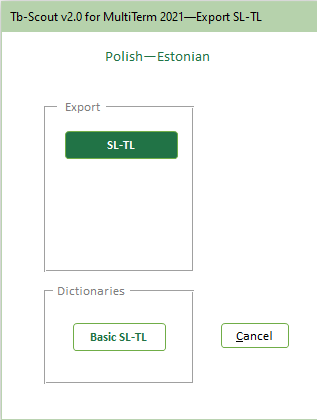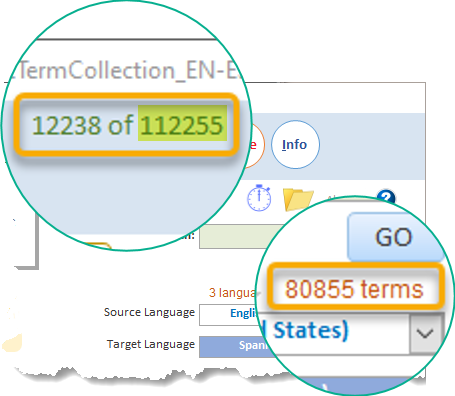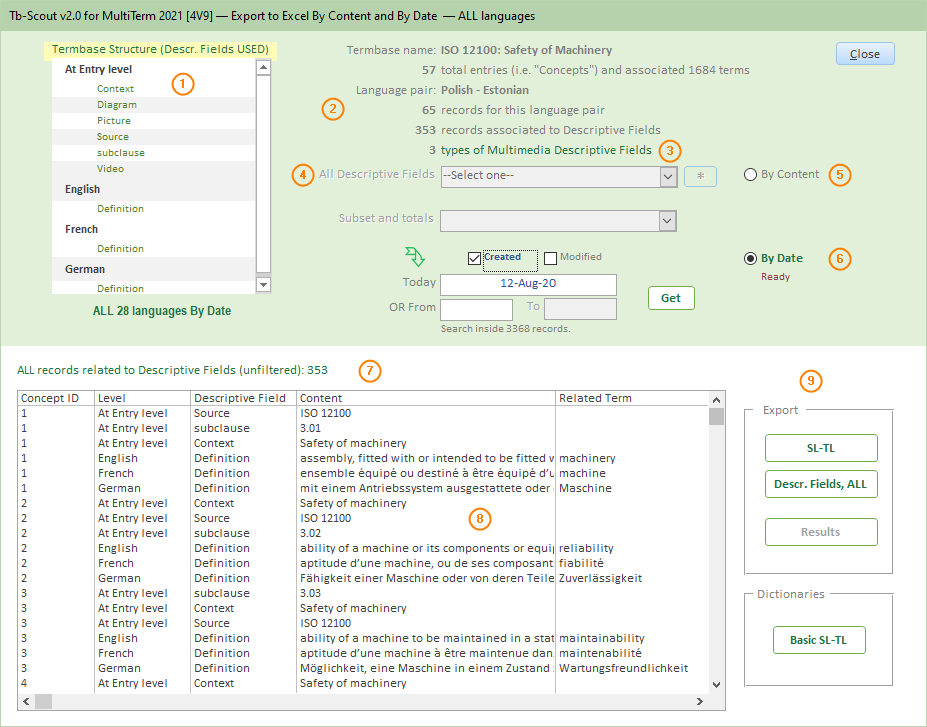Here is a no-nonsense way of exporting termbases to Excel
This unique tool will allow you to export your MultiTerm termbases into Microsoft Excel in plain text.
It will do it by bilingual pairs and in a matter of just a few seconds. Guaranteed.
Very important to consider this
Unlike exporting to the standard TBX format or to XML files (which you will anyhow always need to exchange data with other CAT tools), this function quickly and practically exports data in plain text to Excel worksheets (or PDF files) ready to be used for other purposes, like sending a bilingual list of terms to another colleague or to a client. You simply need not worry about conversions.
If you actually need to export your data into standard formats for terminology like TBX, then you should use another tool.
Tb-Scout v2.5 exports only to Excel (.xlsx), Acrobat PDF (.pdf) and text (.txt) formats.
A fast and simple way of exporting your data in plain text
With this core module of Tb-Scout v2.5, called the "Export module", you will be able to export selected data from an SDL termbase into Microsoft Excel or PDF documents in plain text (i.e. no conversion is needed). However, before getting into the actual export module you are presented with 4 different options (or 3, if the termbase has only two languages), of which option 3a. and 3b. deal with descriptive fields. If the termbase you are exploring does not have descriptive fields (and you will be informed about that) the export module will still be available with the other types of export processes available.

- Get an instant report, during the fastest processing time of all 4 processes (or 3, it depends), that it takes only a few seconds to be produced.
- Get a bilingual glossary ready to be exported to Excel or get a bilingual dictionary of the selected language pair. This selection will take you to a small form (Figure 2, below) with two main choices: Export to Excel or create a basic dictionary.
- There are two options here (back to Figure 1): 3a. for processing descriptive fields and dates for the selected language pair, and 3b. for processing descriptive fields and dates for all languages present in the termbase. These two options involve a slow and the slowest processing time, respectively. However, when a termbase has 0 descriptive fields the process will run much faster.
- This indicator serves to speed things up. If you are reviewing the same termbase and coming back and forth, this label will inform you about the previous selection, i.e. process, allowing the application to skip that process and jump back into the Export module (Figure 5, below). If you want to restart the process, just click this button to reset the type of processing (1., 2., 3a. or 3b.) to create a fresh new dataset.
- This label will indicate how fast a process works, from the fastest (1.) to the slowest (3b.) processing time.

Please note that if you just want to get a bilingual glossary or a dictionary, use option 2.
Options 1 and 2 do not open the Export module.
Options 3a. and 3b. are meant for extracting data related to descriptive fields and dates (Figure 1, above). Either of these options will open the Export module.
See also scope and limitations when it comes to processing data.

Please also note how the number of terms (80,855), in Figure 3 above, is different from the total number of records being processed when option 3b. for all languages, in Figure 1, above, is selected.
This number 112,255 includes, in addition to terms, records for two additional descriptive fields in the test termbase used for this example.
According to the scope and limitations of Tb-Scout v2.5 the application may stop working here.

At any rate, there is a visible progress counter on the top of the Main form (Figure 4, above), a visual clue to indicate that the application is working. Sometimes you may not see this progress counter but the Export module that appears suddenly with the results.
Export module user interface

- Structure of the termbase being explored. You will only see a) the descriptive fields USED, meaning this list will show only those termbase levels in which there is a descriptive field AND it has some content, and therefore you will also only see b) the languages that have entries that include descriptive fields. To see all descriptive fields, whether used or not used, see the pull-down list in (4). In addition, in pane (1) the language names with the prefix "I-", if any, refer to the index (or language) level of the termbase.
- Basic termbase statistics including for the language pair selected.
- Information of the number and name of multimedia descriptive fields. To get the names of the actual multimedia descriptive fields names just click where it says "types of Multimedia Descriptive Fields". These field names should also appear on pane (1), above.
- To see All descriptive fields present in the termbase, select "By Content" (5) and then click the pull down list where it says "--select one--" to filter by descriptive field, and then, in turn, to filter even more each particular result by using the "Subset and totals" pull down list, below (4). Notice also how in pane (1) you will see only the descriptive fields used in the termbase (as explained above). When no data is available there will be and indication of that below the pull-down list. The asterik button to the right serves as a way to reset the dataset (8) to its full content.
- Select data to export according to content, which will activate the pull-down lists in (4) and below.
- Select data to export according to date. By default, the current date (i.e. today's date) will be shown and by pressing the [Get] button you will see the corresponding records, if any. You can search by "Created" and "Modified" dates. By pressing the green arrow icon, the dates are reset to "Today's date".
- The description of the resulting dataset (8) from either "All Descriptive Fields" or "Subset and totals" pull-down lists.
- By double-clicking any row of this resulting dataset you will get a Bird's Eye View of the whole entry corresponding to that particular Concept ID.
- The available exporting options.
Types of data exported to Excel (or PDF)
Tb-Scout v2.5 is a companion terminology tool for translators who use MultiTerm and other CAT tools |
|